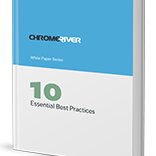 To reveal hidden trends and opportunities, companies can use analytics software to sift enormous amounts of data, looking for an edge. As businesses seek to benefit from “big data,” managers increasingly rely on analytics-based reports to guide their decision-making, according to a post on the Big Fat Finance Blog. A great way for your company to benefit from big-data analytics is by using expense management software.
To reveal hidden trends and opportunities, companies can use analytics software to sift enormous amounts of data, looking for an edge. As businesses seek to benefit from “big data,” managers increasingly rely on analytics-based reports to guide their decision-making, according to a post on the Big Fat Finance Blog. A great way for your company to benefit from big-data analytics is by using expense management software.
Good expense management software like Chrome River EXPENSE helps executives spot trends and improve their business expense tracking, and it delivers transparency around all your cost centers. The most common analytics tools are descriptive, according to Big Fat Finance, providing detailed outlines of current business situations. In expense management, for example, executives might use a product like Chrome River ANALYTICS to review past expenses, analyze current ones, and compare past and present amounts.
Finding it difficult to choose the best analytics tools for your business? Big Fat Finance includes a number of features to consider. They suggest companies find a solution that …
- Connects a complete company overview to detailed data. Users should be able to track global and departmental spending and cost center activity, but also drill down to such details as individual user activity.
- Provides value by combining robust features and low cost. Some cloud-based analytics systems also allow employees to work in a disconnected mode, which can offer significant network cost savings.
- Stores data securely, while providing convenient access. Using a cloud-based analytics service means you no longer need to secure data in-house. A cloud-based platform makes powerful expense management applications readily available via web portals and secure mobile apps.
- Requires minimal IT intervention. If you’d rather not involve IT in these projects, intuitive, cloud-based expense management software can help employees generate even complex reports, charts and dashboards from multiple enterprise information sources.
- Interacts smoothly and securely with other business intelligence tools. Look for solutions that integrate with your proprietary systems and multidimensional enterprise-information sources.
- Produces flexible, customizable reports and displays. A good solution should allow users to easily create dashboards and output reports in a variety of formats, like HTML, Excel and PowerPoint.
If you want fast, effective decision-making and smooth daily operations, make it easy for employees of all skill levels to create the reports and analyses they need. Choosing a good expense management software system provides the tools you need to do that.
What analytics tools does your business use? What features have you found to be most important? Share your thoughts below in the comments section!
Source: Big Fat Finance Blog, February 2013
Subscribe
Latest Posts
Posts by Category
I just love the Chrome River application. I could probably sell it! Finance Administrative Coordinator Law Firm, 800 Employees
Can’t we just move year-end, so that we can roll out Chrome River sooner!? Financial Systems Director Law Firm, 300 Employees


Comments